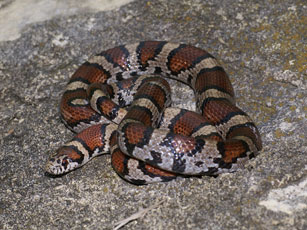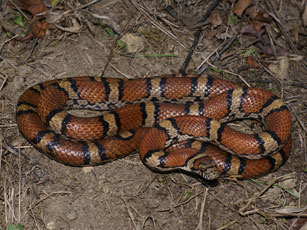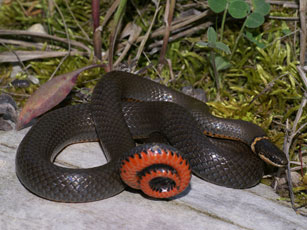
5-18-07
Trip Details
Iowa Herpalooza - Day 1
photo by Joe Monahan, Iowa HerpNet
Start Time: 9:30 a.m.
Weather: Sunny. Start temp around 75 degrees. Low wind.
Location: Madison County, Iowa
Herpers: Jeff LeClere, Joe Monahan, Jim Scharosch & Matt Ricklefs
Account by: Matt Ricklefs
Photos by: Jim Scharosch except where noted
Thought of the Day: The Herps of Madison County
For some time Jim and I had decided that we need to to do a tour de force (if you will) of Iowa. It seems like in the spring, we always hit our normal spots and often other states, but we had not taken several days to do JUST Iowa. This trip was that.
The day started with meeting up with Jeff. He had just finished some grueling field work, and with a couple of hours of sleep, he journeyed down to meet us from Minnesota. He informed us that Joe would also be joining us. I had known of Joe for some time, but this was my first chance to get out and herp with him. As luck would have it, his timing was excellent. He arrived just as we had at the first location.
Right before Joe arrived, Jim and I tackled a two-fer rock (taking two to turn) and were awarded with a two-fer. Two Milk Snakes (Lampropeltis triangulum).
One was approximately forty inches and the other was a bit smaller at approximately thirty-six inches. Both were nice snakes, but one had wide black borders and a small blotch count and the overall effect was quite stunning. Being a large Milk made it all the better. A good start to the day. After a healthy compliment of pictures, we let them go under the rock. These two were male and female and did seem to have finished or be preparing to breed. AMORE!!
A short time later Jim found a juvenile Milk Snake at approximately seven inches. It had an interesting head pattern.
This one Three milks to start the day was a good sign.
We car caravaned to the next location, however it was still a bit early as the sun had not exposed and warmed the area quite enough yet. We decided to go to another spot and return here later. Off we went.
We arrived at the next location which is a good sized location. After a little looking we encountered our fourth Milk.
This one was about sixteen inches. A nice representation of Milks this size overall in Iowa. At this time it was about 11:30 a.m. It's funny how you need to factor in a fair amount of time for picture taking. The more herps you find the more time it takes to photograph. The more herps you find also means the less total time in the day you have to find more. I guess it's a fair price to pay. I'll always take finding the max amount of herps.
Our next find was a welcome one. As it was warming up nicely (with an eventual high of about 82 degrees) we figured we might find some out trying to balance warming with not over warming. In a small crag of rock under dappled sunlight was out first Crotalus horridus - the Timber Rattlesnake.
It was quite picturesque. We cautiously approached to get some situ shots. It sat fairly well as we rotated picture taking. If you have been herping and have studied herping this was that scene that is explained or shown in many books. It was magical. As it sat nicely, after some pics we made attempts to get closer and lean aside some of the vegetation for better pics. As Jeff carefully leaned some of the plants in front of it aside, it saw the end of the tongs. It had been still then flicked (its tongue) a bit showing it was aware of something, or at least trying to figure out what was going on. As the tong came in sight, it moved. Not spooked, but in a predatory stance. That was cool. It did not take long to figure out that a.) this is not prey and b.) I'm going to go now. We did decide to bring it out for some more body shots.
It was about twenty-six inches and of the brownish phase. It was a bit dusty/dirty. It did have smaller chevron/blotches that provided a unique pattern. Timbers in general are quite variable. Whether it is snake to snake in an area, state to state or even the debate of Timbers and Canbrakes. This provides a lot of fun in finding them and I think all those who herp up Timbers appreciate this. This is also a good example of getting a situ shot which is always nice and the fact that in order to get further or better shots wrangling and posing is necessary. Sorry to expose this "secret" to anyone who does not know this.
As we worked our way along, Jim found a juvenile milk along the ridge line.
It was another pretty one, with a deep red coloration and light background color.
Obviously wrangling and posing venomous species presents many complications. The next find however did not present difficultly but it is very hard for a situ shot. This one was Milk snake number six AND SEVEN. Joe had flipped a shelf rock in some rock jumble and scored a double - nicely done Joe. One was about twenty-four inches. It had large blotches and a the background color was kind of orange. It had a corn snake look to it.
The red blotches were lighter red and the black border was thick. A pretty snake. The other was a little smaller at about twenty-one inches. It was perhaps a little darker, but was also quite ready for shed.
Once shed I'm sure this one was also a nice looking snake. After we caught the Milks and were getting to an area for pictures we spied and caught a Garter Snake (Thamnophis sirtalis) as well.
photos by Matt Ricklefs
This one was out on the move. It was about twenty-four inches. We had heard/saw a few others on the move, but this one was just in reach and since we were getting ready for pics it was a nice addition. After picture time, it was time to move on.
Under a large rock was a small rock near the edge. On that rock was, can you guess? Milk Snake number eight.
photo by Matt Ricklefs
This one was small and blue eyed. About six inches long. Again, once shed this one would look nice. I got a situ and reference shot and we moved on.
It was about 1:30 p.m. now and about as warm as it was going to get. We had been fortunate in that we were finding snakes with nicely spaced regularity. Jim had been mentioning how nice the area we were in at this time was for Timbers and we had been discussing the fact that with the warmth the previous one liked the dappled sun. Just then Jim said "There's one".
It was, of course, Timber number two. It's funny how that works when you are discussing something and then there's a critter. We took in situ pictures of this one and didn't bother it. This one was also about the same size. It was also dusty/dirty, but this one was lighter and with more yellowish than brown. Other than scurrying garters along the trail this was to be our last find at this location.
We drove to a site we checked quickly and then moved on. The next location we herped was a small area that had produced some smaller species of snakes in the past. We uncovered three Prairie Ring-Neck Snakes (Diadophis punctatus arnyi).
photo by Matt Ricklefs
The largest was one we took considerable amount of time to document properly as it was a species record to date. It measured out at sixteen and seven-eighths inches long and was a gravid female. It was fairly typical in coloring for Iowa Ring-Necks and was pretty, and it was a monster.
It was getting late (about 4:00 p.m.) and we went back to the area we had gone to earlier in the day. It was nicely exposed and had had a chance to warm up. Our first find was a new species for the day and one that I had not seen yet this year - a Racer (Coluber constrictor).
photo by Matt Ricklefs
It was a juvenile, about eight inches long and blue eyed. I did get a few pics before I heard Jeff exclaim - TIMBER! I finished up and went over to where the others were. Jeff had spied one, not easy to see, under the edge of a rock. It was a large rock, but turnable. This would be a cooperative effort. We all took our places - two to uncover and two to prepare to wrangle. If you find one, especially under a nice sized rock, there is always a chance that others may be around. This is a great advantage when herping with others. We readied ourselves and upon uncovering discovered not only the large one that Jeff had spied but a smaller one under the same rock - another two-fer!! Nicely done Jeff. When wrangling and posing, you usually find a nice area for pics. As luck would have it and as you can see our best place ended up being white gravel. Not optimal, but it works in a pinch. The larger was good sized at about thirty-six inches. This was again the typical brownish phase, with a bit darker coloration .
The smaller was about twenty-seven inches and was lighter with more greys mixed in.
A little more similar to Kansas Timbers. Again, these are highly variable and this is part of the fun. Besides being nice in just finding many snakes for a snake count, it is also nice because with many snakes (like Milks and Timbers) you get to clearly see many variances.
It was about 5:00 p.m. now and we decided to call it a day. We did get together for dinner at a fast food joint and recounted the days finds. Jeff and Jim even ordered Strawberry Milk Snakes (shakes). The person taking the order didn't catch it said either time. Funny. We herpers are a fun bunch. It was a pleasure herping with Joe for the first time (for me) as he is really a nice guy. It had been a while since I had seen and herped with Jeff and this was great. Jeff is a good friend and it was nice to get out. The camaraderie among herpers especially and in many cases others who are just naturalists or enthusiasts is a cool thing. The other nice thing is going over what others had found and what is discussed and debated on forums like Field Herp Forum.
Among the flowing rivers, open expanses and majestic rock outcroppings of Iowa we found peace and beauty. The serenity of nature in harmony with us and the awesome beauty that is - the herps of Madison County. ; )
Stay tuned for day 2 - Same Herp time, same herp channel!


































